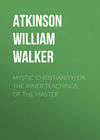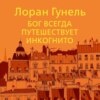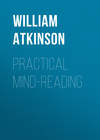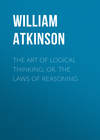Kitobni o'qish: «Mystic Christianity; Or, The Inner Teachings of the Master»
The Project Gutenberg eBook, Mystic Christianity, by Yogi Ramacharaka
This eBook is for the use of anyone anywhere at no cost and with almost no restrictions whatsoever. You may copy it, give it away or re-use it under the terms of the Project Gutenberg License included with this eBook or online at www.gutenberg.net
Title: Mystic Christianity
Author: Yogi Ramacharaka
Release Date: August 9, 2004 [eBook #13143]
Language: English
***START OF THE PROJECT GUTENBERG EBOOK MYSTIC CHRISTIANITY***
E-text prepared by Juliet Sutherland, Keith M. Eckrich, and the Project Gutenberg Online Distributed Proofreading Team
MYSTIC CHRISTIANITY
Or, The Inner Teachings of the Master
by
YOGI RAMACHARAKA
Author of "Fourteen Lessons in Yogi Philosophy and Oriental
Occultism," "Hatha Yoga," "Science of Breath," "Advanced Course in
Yogi Philosophy," "Raja Yoga," "Psychic Healing," "Gnani Yogi," etc.
THE FIRST LESSON
THE COMING OF THE MASTER
THE FORERUNNER
Strange rumors reached the ears of the people of Jerusalem and the surrounding country. It was reported that a new prophet had appeared in the valley of the lower Jordan, and in the wilderness of Northern Judea, preaching startling doctrines. His teachings resembled those of the prophets of old, and his cry of "Repent! Repent ye! for the Kingdom of Heaven is at hand," awakened strange memories of the ancient teachers of the race, and caused the common people to gaze wonderingly at each other, and the ruling classes to frown and look serious, when the name of the new prophet was mentioned.
The man whom the common people called a prophet, and whom the exalted ones styled an impostor, was known as John the Baptist, and dwelt in the wilderness away from the accustomed haunts of men. He was clad in the rude garments of the roaming ascetics, his rough robe of camel's skin being held around his form by a coarse girdle of leather. His diet was frugal and elemental, consisting of the edible locust of the region, together with the wild honey stored by the bees of the wilderness.
In appearance John, whom men called "the Baptist," was tall, wiry, and rugged. His skin was tanned a dark brown by the winds and sun which beat upon it unheeded. His long black hair hung loosely around his shoulders, and was tossed like the mane of a lion when he spoke. His beard was rough and untrimmed. His eyes gleamed like glowing coals, and seemed to burn into the very soul of his hearers. His was the face of the religious enthusiastic with a Message for the world.
This wild prophet was most strenuous, and his teachings were couched in the most vigorous words. There was no tact, policy, or persuasion in his message. He hurled his verbal thunderbolts right into his crowd, the very force and earnestness emanating from him serving to charge his words with a vitality and magnetism which dashed itself into the crowd like a spark of electricity, knocking men from off their feet, and driving the Truth into them as if by a charge of a powerful explosive. He told them that the spiritual grain was to be gathered into the garners, while the chaff was to be consumed as if by a fiery furnace; that the axe was to be laid to the root of the trees which brought not forth good fruit. Verily, the "Day of Jehovah," long promised by the prophets, was near to hand to his hearers and followers.
John soon gathered to himself a following, the people flocking to him from all parts of the country, even from Galilee. His followers began to talk among themselves, asking whether indeed this man were not the long promised Master—the Messiah for whom all Israel had waited for centuries. This talk coming to the ears of the prophet, caused him to answer the question in his discourses, saying: "There cometh one mightier than I, after me, the latchet of whose shoes I am not worthy to stoop down and unloose; he that cometh after me is mightier than I." And thus it became gradually known to his following, and the strangers attending his meetings, that this John the Baptist, mighty preacher though he be, was but the herald of one much greater than he, who should follow—that he was the forerunner of the Master, according to the Oriental imagery which pictured the forerunner of the great dignitaries, running ahead of the chariot of his master, crying aloud to all people gathered on the road that they must make way for the approaching great man, shouting constantly, "Make ye a way! make ye a way for the Lord!" And accordingly there was a new wave of excitement among John's following, which spread rapidly to the surrounding country, at this promise of the coming of the Lord—the Master—perhaps even the Messiah of the Jews. And many more came unto John, and with him waited for the Coming of the Master.
This John the Baptist was born in the hill country of Judea, nearly thirty years before he appeared as a prophet. His father was of the priestly order, or temple caste, who had reached an advanced age, and who lived with his aged wife in retirement, away from the noise and confusion of the world, waiting the gradual approach of that which cometh to all men alike. Then there came to them a child of their old age, unexpected and unhoped for—coming as a mark of especial favor from God—a son, to whom they gave the name of Johanan, which in the Hebrew tongue means "Jehovah is gracious."
Reared in the home of his parents—the house of a priest—John saturated himself with all the Inner Teachings reserved for the few, and withheld from the masses. The Secrets of the Kaballah, that system of Hebrew Occultism and Mysticism in which the higher priests of Judea were well versed, were disclosed to him, and occult tradition has it that he was initiated into the Inner Circle of the Hebrew Mystics, composed of only priests of a certain grade, and their sons. John became an Occultist and a Mystic. When the boy reached the age of puberty, he departed from the home of his parents, and went into the wilderness, "looking to the East, from whence cometh all Light." In other words, he became an Ascetic, living in the wilderness, just as in India even to-day youths of the Brahmin or priestly class sometimes forsake their homes, renouncing their luxurious life, and fly to the jungle, where they wander about for years as ascetics, wearing a single garment, subsisting on the most elementary food, and developing their spiritual consciousness. John remained a recluse until he reached the age of about thirty years, when he emerged from the wilderness to preach the "Coming of the Lord," in obedience to the movings of the Spirit. Let us see where he was, and what he did, during the fifteen years of his life in the wilderness and hidden places of Judea.
The traditions of the Essenes, preserved among Occultists, state that while John was an ascetic he imbibed the teachings of that strange Occult Brotherhood known as the Essenes, and after having served his apprenticeship, was accepted into the order as an Initiate, and attained their higher degrees reserved only for those of developed spirituality and power. It is said that even when he was a mere boy he claimed and proved his right to be fully initiated into the Mysteries of the Order, and was believed to have been a reincarnation of one of the old Hebrew prophets.
THE ESSENES
The Essenes were an ancient Hebrew Occult Brotherhood, which had been in existence many hundred years before John's time. They had their headquarters on the Eastern shores of the Dead Sea, although their influence extended over all of Palestine, and their ascetic brothers were to be found in every wilderness. The requirements of the Order were very strict, and its rites and ceremonies were of the highest mystical and occult degree. The Neophyte was required to serve a preliminary apprenticeship of one year before being admitted to even partial recognition as a member and brother. A further apprenticeship of two more years was required before he was admitted to full membership, and extended the right hand of fellowship. Additional time was required for further advancement, and even time alone did not entitle the member to certain high degrees, the requirements being that actual knowledge, power and attainment must first be manifested. As in all true Occult Orders the candidate must "work out his own salvation," neither money nor influence having any weight.
Absolute obedience to the Rules of the Order; absolute poverty of material possessions; absolute sexual continence—these were the conditions of membership to be observed by both Neophyte and Initiate, as well as High-degree Master. Understanding this, one may imagine the disgust inspired in John by the amorous solicitations of Salome, which caused him to lose his life rather than to break the vows of his Order, as is so startlingly pictured in the stage productions of modern times.
One of the ceremonies of the Essenes was that of Baptism (literally, "dipping in water") which was administered to Candidates, with appropriate solemnity and rites. The mystic significance of the ceremony which is understood by all members of Occult Orders, even unto this day, was a part of the ritual originated by the Essenes, and the rite itself was a distinctive feature of their Order. The performance of this rite by John the Baptist, in his ministry, and its subsequent acceptance by the Christian Church as a distinctive ceremonial, of which the "sprinkling of infants" of to-day is a reminder and substitute, forms a clear connecting link between the Essenes and Modern Christianity, and impresses the stamp of Mysticism and Occultism firmly upon the latter, as little as the general public may wish to admit it in their ignorant misunderstanding and materialistic tendencies.
The Essenes believed in, and taught the doctrine of Reincarnation; the Immanence of God; and many other Occult Truths, the traces of which appear constantly in the Christian Teachings, as we shall see as we progress with these lessons. Through its Exalted Brother, John the Baptist, the Order passed on its teaching to the early Christian Church, thus grafting itself permanently upon a new religious growth, newly appearing on the scene. And the transplanted branches are still there!
Of course, the true history of the real connection between the Essenes and Christianity is to be found only in the traditions of the Essenes and other ancient Mystic Orders, much of which has never been printed, but which has passed down from teacher to pupil over the centuries even unto this day, among Occult Fraternities. But in order to show the student that we are not making statements incapable of proof by evidence available to him, we would refer him to any standard work of reference on the subject. For instance, if he will consult the "New International Encyclopedia" (Vol. VII, page 217) article on "Essenes," he will read the following words:
"It is an interesting question as to how much Christianity owes to Essenism. It would seem that there was room for definite contact between John the Baptist and this Brotherhood. His time of preparation was spent in the wilderness near the Dead Sea; his preaching of righteousness toward God, and justice toward one's fellow men, was in agreement with Essenism; while his insistence on Baptism was in accord with the Essenic emphasis on lustrations."
The same article contains the statement that the Essenic Brotherhood taught a certain "view entertained regarding the origin, present state, and future destiny of the soul, which was held to be pre-existent, being entrapped in the body as in a prison," etc. (The above italics are our own.)
John emerged from the wilderness when he had reached the age of about thirty years, and began his ministry work, which extended for several years until his death at the hands of Herod. He gathered around him a large and enthusiastic following, beginning with the humbler classes and afterward embracing a number of higher social degree. He formed his more advanced followers into a band of disciples, with prescribed rules regarding fasting, worship, ceremonial, rites, etc., closely modeled upon those favored by the Essenes. This organization was continued until the time of John's death, when it merged with the followers of Jesus, and exerted a marked influence upon the early Christian church.
As we have stated, one of his principal requisites enjoined upon all of his followers, was that of "Baptism"—the Essenic rite, from which he derived his familiar appellation, "The Baptist." But, it must be remembered that to John this rite was a most sacred, mystic, symbolic ceremony, possessing a deep occult meaning unperceived by many of his converts who submitted themselves to it under the fervor of religious emotion, and who naïvely regarded it as some magical rite which "washed away sin" from their souls, as the dirt was washed from their bodies, a belief which seems to be still in favor with the multitude.
John worked diligently at his mission, and the "Baptists" or "Followers of Johanan," as they were called, increased rapidly. His meetings were events of great moment to thousands who had gathered from all Palestine to see and hear the prophet of the wilderness—the Essene who had emerged from his retirement. His meetings were often attended with startling occurrences, sudden conversions, visions, trances, etc., and many developed possession of unusual powers and faculties. But one day there was held a meeting destined to gain world-wide fame. This was the day when there came to John the Baptist the MASTER, of whose coming John had frequently foretold and promised. JESUS THE CHRIST appeared upon the scene and confronted his Forerunner.
The traditions have it that Jesus came unannounced to, and unrecognized by John and the populace. The Forerunner was in ignorance of the nature and degree of his guest and applicant for Baptism. Although the two were cousins, they had not met since childhood, and John did not at first recognize Jesus. The traditions of the Mystic Orders further state that Jesus then gave to John the various signs of the Occult Fraternities to which they both belonged, working from the common signs up until Jesus passed on to degrees to which John had not attained, although he was an eminent high-degree Essene. Whereupon John saw that the man before him was no common applicant for Baptism, but was, instead, a highest-degree Mystic Adept, and Occult Master—his superior in rank and unfoldment. John, perceiving this, remonstrated with Jesus, saying that it was not meet and proper, nor in accordance with the customs of the Brotherhoods, for the inferior to Baptize the superior. Of this event the New Testament takes note in these words: "But John forbade him, saying, I have need to be baptized of thee, and comest thou to me?" (Matt. 3:14.) But Jesus insisted that John perform the rite upon him upon the ground that He wished to go through the ceremonial in order to set His stamp of approval upon it, and to show that he considered himself as a man among men, come forth to live the life of men.
In both the occult traditions and the New Testament narrative, it is stated that a mystical occurrence ensued at the baptism, "the Spirit of God descending like a dove and lighting upon Him," and a voice from Heaven saying: "This is my beloved Son in whom I am well pleased."
And with these words the mission of John the Baptist, as "Forerunner of the Master," was fulfilled. The Master had appeared to take up his work.
THE MASTER
And, now, let us turn back the pages of the Book of Time, to a period about thirty years before the happening of the events above mentioned. Let us turn our gaze upon the events surrounding the birth of Jesus, in order that we may trace the Mystic and Occult forces at work from the beginning of Christianity. There are occurrences of the greatest importance embraced in these thirty years.
Let us begin the Mystic Narrative of Jesus the Christ, as it is told to the Neophyte of every Occult Order, by the Master Instructor, by a recital of an event preceding his birth by over one year.
In Matthew 2:1-2, the following is related:
"Now when Jesus was born in Bethlehem of Judea, in the days of Herod the king, behold, there came Wise Men from the East to Jerusalem, saying, Where is he that is born King of the Jews? for we have seen his star in the East, and are come to worship him."
In these simple words is stated an event that, expressed in a much more extended narrative, forms an important part of the Esoteric Teachings of the Mystic Brotherhoods, and Occult Orders of the Orient, and which is also known to the members of the affiliated secret orders of the Western world. The story of THE MAGI is embedded in the traditions of the Oriental Mystics, and we shall here give you a brief outline of the story as it is told by Hierophant to Neophyte—by Guru to Chela.
To understand the story, you must know just who were these "Wise Men of the East"—The Magi. And this you shall now be taught.
THE MAGI, OR WISE MEN
The translators of the New Testament have translated the words naming these visitors from afar as "the Wise Men from the East," but in the original Greek, Matthew used the words "The Magi" as may be seen by reference to the original Greek versions, or the Revised Translation, which gives the Greek term in a foot-note. Any leading encyclopedia will corroborate this statement. The term "the Magi" was the exact statement of Matthew in the original Greek in which the Gospel was written, the term "the Wise Men" originating with the English translators. There is absolutely no dispute regarding this question among Biblical scholars, although the general public is not aware of the connection, nor do they identify the Wise Men with the Oriental Magians.
The word "Magi" comes to the English language direct from the Greek, which in turn acquired it by gradual steps from the Persian, Chaldean, Median, and Assyrian tongues. It means, literally, "wonder worker," and was applied to the members of the occult priestly orders of Persia, Media, and Chaldea, who were Mystic Adepts and Occult Masters. Ancient history is full of references to this body of men. They were the custodians of the world's occult knowledge for centuries, and the priceless treasures of the Inner Teachings held by the race to-day have come through the hands of these men—the Magi—who tended the sacred fires of Mysticism and kept The Flame burning. In thinking of their task, one is reminded of the words of Edward Carpenter, the poet, who sings: "Oh, let not the flame die out! Cherished age after age in its dark caverns, in its holy temples cherished. Fed by pure ministers of love—let not the flame die out."
The title of "Magi" was highly esteemed in those ancient days, but it fell into disrepute in the latter times owing to its growing use as an appellation of the practitioners of "Black Magic," or "evil wonder-workers" or sorcerers, of those days. But as a writer in the New International Encyclopedia (Vol. XII, page 674) has truly said:
"The term is employed in its true sense by Matthew (2:1) of the wise men who came from the East to Jerusalem to worship Christ. The significance of this event must be observed because the Messianic doctrine was an old and established one in Zoroastrianism."
The same article says of the Magi: "… they believed in a resurrection, a future life, and the advent of a savior."
To understand the nature of the Magi in connection with their occult "wonder working," we must turn to the dictionaries, where we will see that the word "Magic" is derived from the title "Magi;" the word "Magician" having been originally "Magian", which means "one of the Magi." Webster defines the word "Magic" as follows: "The hidden wisdom supposed to be possessed by the Magi; relating to the occult powers of nature; mastery of secret forces in nature", etc. So you may readily see that we are right in stating to you that these Wise Men—the Magi who came to worship the Christ-child, were in reality the representatives of the great Mystic Brotherhoods and Occult Orders of the Orient—Adepts, Masters, Hierophants! And thus do we find the Occult and Mystic "wonder workers"—the high-degree brethren of the Great Eastern Lodges of Mystic Occultism, appearing at the very beginning of the Story of Christianity, indicating their great interest in the mortal birth of the greater Master whose coming they had long waited—the Master of Masters! And all Occultists and Mystics find pleasure and just pride in the fact that the first recognition of the Divine Nature of this human child came from these Magi from the East—from the very Heart of the Mystic Inner Circles! To those so-called Christians to whom all that is connected with Mysticism and Occultism savors of the fiery sulphur and brimstone, we would call attention to this intimate early relation between The Musters and THE MASTER.



















